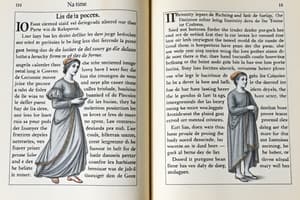Podcast
Questions and Answers
¿En qué año fue publicada por primera vez La Comedia de Calisto y Melibea?
¿En qué año fue publicada por primera vez La Comedia de Calisto y Melibea?
- 1541
- 1499 (correct)
- 1502
- 1599
¿Quién continuó la obra de La Celestina después de una persona desconocida?
¿Quién continuó la obra de La Celestina después de una persona desconocida?
- Pleberio
- Alisa
- Fernando de Rojas (correct)
- Calisto
¿Qué tipo de lenguaje usa Fernando de Rojas en La Celestina?
¿Qué tipo de lenguaje usa Fernando de Rojas en La Celestina?
- Culto y académico (correct)
- El lenguaje de la gente común
- Un lenguaje paródico
- Un lenguaje moderno
¿Cuáles son los personajes principales de La Celestina?
¿Cuáles son los personajes principales de La Celestina?
¿Qué tema principal aborda La Celestina?
¿Qué tema principal aborda La Celestina?
Flashcards are hidden until you start studying
Study Notes
- La Comedia de Calisto y Melibea, written by Fernando de Rojas, was published in 1499 and was re-published with new preliminaries in 1502.
- The text of the final version of La Celestina is based on 16 acts that were originally written by an unknown person and continued by Rojas.
- Rojas was from Toledo and studied law at Salamanca. He married a woman from a Conversa family and lived in a hostile environment towards this minority group. He died in 1541.
- La Celestina is a dialogue between high-class and low-class characters.
- The language is cultured and scholarly and the language of the common people is used according to their social status.
- Rojas uses language to parody the aspects of romantic love that were popular in the 1500s.
- There is a variety of linguistic styles in the work, which is a reflection of the multi-cultural society in which it was written.
- La Celestina is a tragedy written by Fernando de Rojas in the late 1500s.
- The story follows the love triangle between Calisto, Melibea, and Celestina.
- Calisto is a selfish, vain man who loves to parties and gamble. Melibea is a sensible and prudent woman who is blinded by love for Calisto.
- Pleberio and Alisa are the parents of Melibea and they are indifferent to her feelings. Celestina is a complex character who is wise, cunning, and has a past full of ambition.
- The servants (Parmenio and Sempronio) the prostitutes (Elicia and Areusa), and other characters are all motivated by greed and lust, but also have their own individual traits.
- La Celestina concludes the medieval Spanish literary tradition of portraying human conflict in a realistic way. Characters are systematically destroyed without achieving an authentic communication between people. Love, friendship, sincerity, and even literary models from the past all disappear in a competitive and materialistic society. Fernando de Rojas denies new values but offers no alternative. In La Celestina, there seems to be no future, as Pleberio says at the end of the work. Only the prostitutes and servants who survive the crisis have a life, in which they proclaim their solitude.
Studying That Suits You
Use AI to generate personalized quizzes and flashcards to suit your learning preferences.




